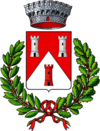Trino
| Trino | ||
|---|---|---|

|
|
|
| Country | Italy | |
| region | Piedmont | |
| province | Vercelli (VC) | |
| Coordinates | 45 ° 12 ' N , 8 ° 18' E | |
| height | 120 m slm | |
| surface | 70 km² | |
| Residents | 6,984 (Dec 31, 2019) | |
| Population density | 100 inhabitants / km² | |
| Post Code | 13039 | |
| prefix | 0161 | |
| ISTAT number | 002148 | |
| Popular name | Trinesi | |
| Patron saint | San Bartolomeo | |
Trino (in Piedmontese Trin ) is a municipality with 6984 inhabitants (as of December 31, 2019) in the Italian province of Vercelli (VC), Piedmont region .
The neighboring municipalities are Bianzè , Camino , Costanzana , Fontanetto Po , Livorno Ferraris , Morano sul Po , Palazzolo Vercellese , Ronsecco and Tricerro .
geography
Trino is located on the left bank of the Po in the Po Valley opposite the Colline del Monferrato . Rice cultivation is predominant in the municipality .
The nature reserve Parco Naturale della Partecipanza dei Boschi preserves one of the last remnants of the landscape of the Po Valley as it was before cultivation.
The Enrico Fermi nuclear power plant in Trino was shut down in 1990.
history
As early as the 2nd century BC there was a Celtic settlement in the municipality of Trino with the name Rigomagus , which appears in various documents from the 7th to 10th centuries and is then gradually replaced by the name Tridinum . The place was probably fortified in Roman times. During excavations since 1984, Roman fortification walls were unearthed near the church of San Michele.
In 1014 Henry II handed over the place, now called Tredino , described as consisting of a few houses and a castle, to the Bishop of Vercelli . In 1101 the castle came to the Marquis of Monferrato, who founded the Abbey of Santa Maria di Lucedio (now the Principato di Lucedio ) in 1123 . This is where rice was first grown in Italy in the 15th century. In 1202 Trino was pledged to the Free City of Vercelli and declared Borgo Franco . This freed the residents from serfdom and the heads of families had the opportunity to determine their own local government. Trino fell back to Monferrato as early as 1253, but his freedoms were largely confirmed. The city began to rise.
In 1432 the Visconti attacked the Monferrato. Their allies, the Savoyans occupied Trino, among others, gave it back to Monferrato as a fief . In 1533 Trino came to the Gonzaga together with the Monferrato . However, since the Savoy also laid claim to the duchy, a period of wars began between the regional powers, behind which France and Spain stood. Trino was also affected, for example in 1541 when it was besieged and conquered by the French. In 1613 it was besieged again by the Savoy. Although the citizens were on their own, they were able to hold the siege for four days. After further sieges, looting, changes of ownership and epidemics, Trino finally came to Savoy in 1707. But the city was destroyed and bled, the city walls razed. The province of Trino, which had existed since it belonged to Monferrato, was dissolved and Trino became an insignificant rural municipality.
population
| year | population |
|---|---|
| 1871 | 9,916 |
| 1901 | 12,138 |
| 1921 | 11,257 |
| 1951 | 9,737 |
| 1971 | 9,587 |
| 1991 | 8,217 |
| 2001 | 7,605 |
politics
Alessandro Portinaro ( PD ) was elected mayor on May 27, 2013 with 54.1% of the vote.
Partnerships
-
 Chauvigny , France, since 1961
Chauvigny , France, since 1961 -
 Geisenheim , Germany , since 1974
Geisenheim , Germany , since 1974 -
 Banfora , Burkina Faso , since 1999
Banfora , Burkina Faso , since 1999
Attractions
San Michele in Insula is located on the eastern outskirts. The Romanesque church dates back to the 4th century. It contains frescoes from the 13th century.
The parish church of San Bartolomeo was built in the 17th century.
The abbey of Santa Maria di Lucedio, founded in 1123, is located 8 km northwest of Trino and is now an agricultural property (Principato di Lucedio).
Sons and daughters
- Gabriele Giolito de 'Ferrari († 1578), publisher and printer
- Alberto Mandarini (* 1966), jazz trumpeter
- Giuseppe Rossino (1880–1949), Catholic Curia Archbishop
- Luigi Sincero (1870–1936), Cardinal to the Curia
swell
- ↑ Statistiche demografiche ISTAT. Monthly population statistics of the Istituto Nazionale di Statistica , as of December 31 of 2019.
- ↑ ISTAT
Web links
- Page of the municipality (Italian)



